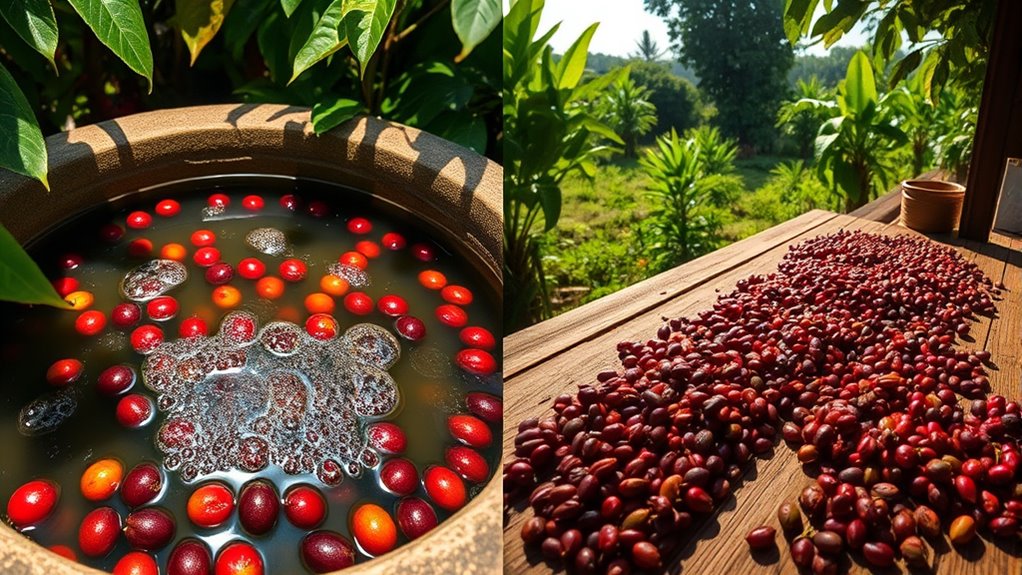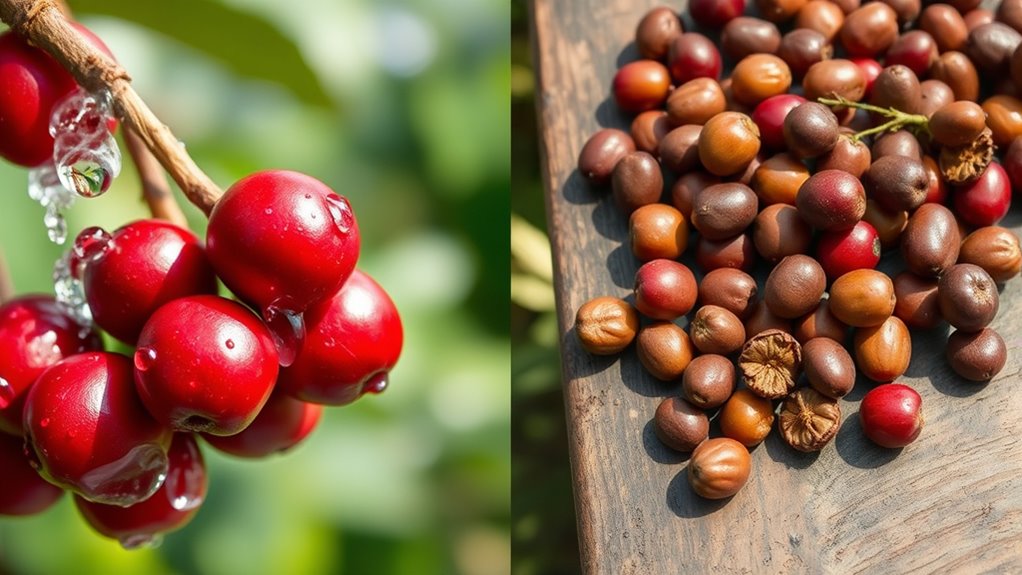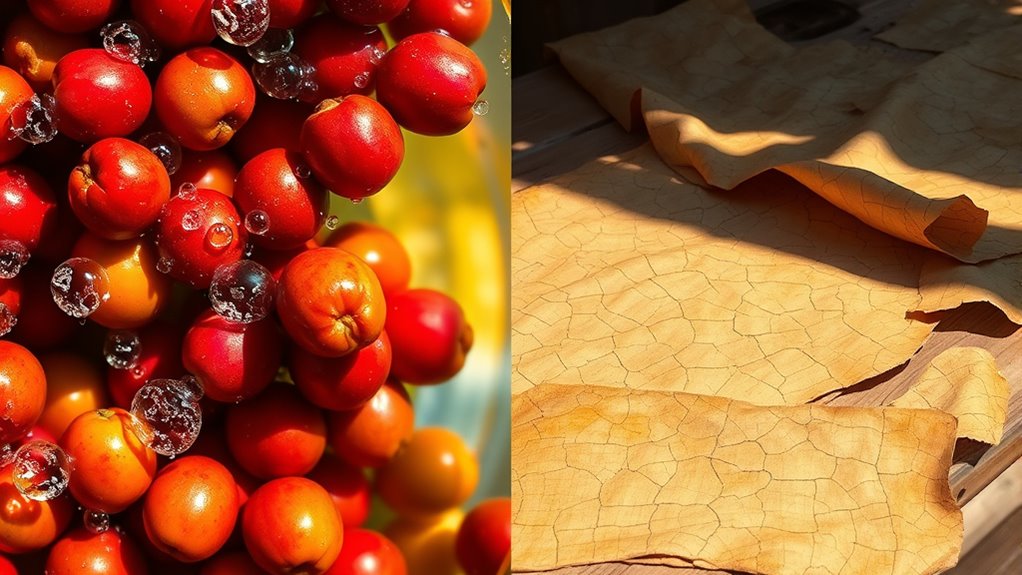Understanding coffee processing starts with the two main methods: wet and dry. Wet processing involves washing and fermenting cherries, resulting in bright, clean flavors with high acidity. In contrast, dry processing leaves the fruit on during drying, leading to earthy, fruity profiles. Your preference might lean toward the clarity of washed coffees or the bold sweetness of natural coffees. There’s so much more to uncover about how these methods affect taste.
Key Takeaways
- Coffee processing methods include dry and wet, each significantly impacting the coffee’s flavor profile and quality.
- The dry method sun-dries whole cherries, leading to earthy, fruity flavors and fuller-bodied profiles.
- The wet method involves washing and fermentation, producing cleaner, brighter coffees with higher acidity.
- Washed coffees highlight intrinsic bean flavors, while natural coffees are known for their intense sweetness and fruit-forward characteristics.
- Understanding these methods helps consumers make informed choices based on their flavor preferences in coffee.
Basics of Coffee Production

Coffee production starts with the careful cultivation of the Coffea tree, which eventually yields coffee cherries.
Once these cherries ripen, it’s time to harvest them, kicking off the next phase: processing.
As the cherries reach their peak ripeness, the crucial step of harvesting begins, leading into the art of processing.
You’ll separate the coffee beans from the fruit using either dry or wet methods.
In dry processing, the cherries are left intact and sun-dried, which often enhances earthy and fruity flavor notes.
Alternatively, wet processing involves removing the fruit before fermentation and drying, resulting in a cleaner taste with higher acidity.
The choice of processing method considerably impacts the final coffee’s flavor profile, making it essential for you to understand these basics of coffee production to appreciate the nuances in different coffee varieties.
A Rundown on the Main Coffee Processing Methods

Two primary coffee processing methods dominate the landscape: dry (natural) and wet (washed).
The dry method, the oldest approach, involves drying whole coffee cherries in the sun for 2-3 weeks. This process retains the fruit during drying, resulting in earthy, fruity flavors.
In contrast, the wet method necessitates multiple steps, including washing the cherries, undergoing a fermentation process, and removing the pulp. This produces cleaner, brighter coffees with higher acidity.
Your choice between these methods can greatly impact your coffee’s flavor profile and quality. The dry method often emphasizes sweetness and body, while the wet method highlights clarity and complexity.
Understanding these coffee processing methods enhances your appreciation and helps you make informed purchasing decisions.
Taste Profiles of Washed and Natural Coffee

The taste profiles of washed and natural coffees reveal the unique characteristics shaped by their processing methods.
Washed coffees, produced through a wet process, typically showcase a cleaner taste with bright acidity, allowing the bean’s intrinsic flavors to shine through while reducing fruity influences from the cherry skin.
Washed coffees highlight a clean taste and bright acidity, enhancing the bean’s natural flavors while minimizing fruity notes.
On the other hand, dry processed (natural) coffees boast intense sweetness and fruit-forward flavors, often resembling berries and offering a fuller-bodied profile. This occurs because the cherry remains intact during drying, enhancing sugar content and resulting in richer tastes.
Coffee drinkers often have varied preferences; some appreciate the clarity and complexity of washed coffees, while others lean toward the bold, fruity characteristics of natural processing.
Each method brings something special to your cup.
The Importance of Coffee Fermentation

While you might enjoy the rich flavors in your cup, understanding the role of fermentation in coffee processing is essential for appreciating those tastes.
Coffee fermentation plays a vital role in developing the flavor profile of coffee beans, breaking down natural sugars to enhance taste complexity. The fermentation process varies between washed coffees and natural coffees; washed coffees undergo controlled fermentation to remove mucilage, while natural coffees ferment with fruit intact, leading to vibrant fruity flavors.
Typically lasting 12 to 48 hours, proper fermentation is key to achieving ideal flavor clarity. However, you must be cautious—over-fermentation can create undesirable tastes, and under-fermentation may prevent the full development of desired characteristics in your coffee.
Exploring Your Coffee Preferences

As you explore your coffee preferences, you’ll discover that the processing method can dramatically influence the flavors in your cup.
Coffee processing methods, particularly wet and dry, create distinct flavor profiles. Wet processing typically yields bright acidity and clarity in washed coffees, highlighting the bean’s inherent quality and flavor.
On the other hand, dry processing can present a wider range of fruity flavors, like citrus and blueberry, as the coffee cherry remains on the beans during drying. This can lead to a fuller-bodied complexity that some coffee lovers enjoy.
Frequently Asked Questions
What Is the Difference Between Wet and Dry Coffee Processing?
When you explore coffee processing, you’ll notice two main methods: wet and dry.
In wet processing, you wash the cherries to remove the fruit before drying, resulting in cleaner flavors and higher acidity.
On the other hand, dry processing keeps the fruit intact, giving you fruitier and earthier notes.
While wet processing is labor-intensive and costly, dry processing is simpler and often used for lower quality beans.
Your choice influences the coffee’s final taste profile.
What Is the Wet and Dry Processing Method?
The wet processing method involves removing the coffee cherry’s skin and pulp, then soaking the cherries in water to guarantee only ripe ones are used.
You’ll notice a cleaner, more acidic flavor in the final cup.
On the other hand, the dry processing method leaves the cherries intact, drying them under the sun for enhanced sweetness and body.
This method is simpler and often results in earthy, fruity notes in your coffee.
What Are the 3 Major Coffee Processing Methods?
Did you know that around 60% of the world’s coffee is processed using the natural method?
When it comes to coffee processing, there are three major methods you should know: the fully washed (or wet) method, the natural (or dry) method, and the honey process.
Each method greatly influences the flavor profile of your coffee, so understanding these techniques can enhance your appreciation for the diverse tastes you’ll encounter in your cup.
What Are the Advantages of Wet Processing of Coffee?
Wet processing offers several advantages for coffee.
You’ll enjoy a cleaner, brighter flavor profile with distinct acidity, enhancing the coffee’s intrinsic qualities. This method helps you select only the ripest cherries, resulting in higher-quality beans.
The fermentation process enriches flavors, allowing for delightful notes like chocolate and caramel.
Though it requires more water and resources, the consistency and quality you gain make the investment worthwhile, especially if you value specialty coffee.
Conclusion
In the grand symphony of coffee, each processing method plays its unique melody. The wet method sings a crisp, bright tune, while the dry method hums a rich, fruity refrain. As you explore these flavors, you’re not just sipping coffee; you’re dancing with tradition and innovation. So, whether you savor the clarity of washed beans or the complexity of naturals, remember, your cup is a canvas, painted with the artistry of the earth. Enjoy the journey!









